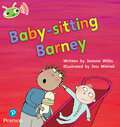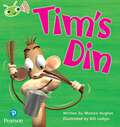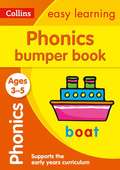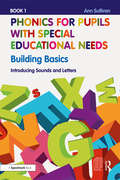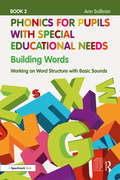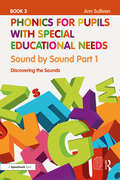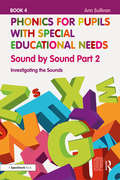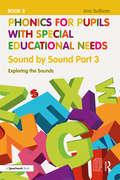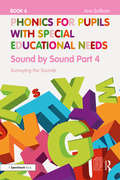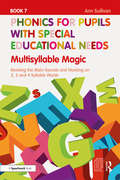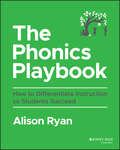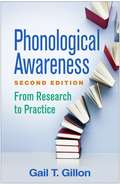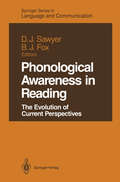- Table View
- List View
Phonics Bug, Phase 5: Babysitting Barney (PDF) (Phonics Bug Ser.)
by Jeanne WillisThis title is part of Phonics Bug - the first Phonics programme to bring together research-based teaching methods with 100 per cent decodable books, CBeebies video, and an online reading world to give today's children a firm, fun foundation in Phonics.Baby Barney will not go to sleep. Can Sid stop him screaming? This book includes the following words: looked, called, asked.
Phonics Bug, Set 01-02: Tim's Din (PDF)
by Mónica HughesThis title is part of Phonics Bug - the first Phonics programme to bring together research-based teaching methods with 100% decodable books, CBeebies video, and an online reading world to give today's children a firm, fun foundation in Phonics. In this book for Phonics Phase 2: Dad naps. Will Tim nap? This title was originally published as part of Rigby Star Phonics.
Phonics Bugs, Phase 3, Set 9: Go Fish! (PDF)
by Jill Atkins Ailie BusbyThis title is part of Phonics Bug - the first Phonics programme to bring together research-based teaching methods with 100% decodable books, CBeebies video, and an online reading world to give today's children a firm, fun foundation in Phonics. In this book for Phonics Phase 3: Neela and Craig have a net and a rod. Where can they get a boat? This book includes the following words: we, are. This title was originally published as part of Rigby Star Phonics.
Phonics Bugs, Phase 3, Set 9: Jumping Jazz (PDF)
by Monica HughesBug Club’s Comics for Phonics are designed to support children with their reading practice and are packed with characters they will love. Finely leveled and 100% decodable. Comics with kid-cred to motivate even the most reluctant reader. Well-structured with a clear pace and progression to get all children reading by 6.
Phonics Bugs, Phase 3, Set 9: Rock-Pooling (PDF)
by Emma LynchThis title is part of Phonics Bug - the first Phonics programme to bring together research-based teaching methods with 100% decodable books, CBeebies video, and an online reading world to give today's children a firm, fun foundation in Phonics. In this book for Phonics Phase 3: We are going rock-pooling. What will we see? This book includes the following words: we, are. This title was originally published as part of Rigby Star Phonics.
Phonics Bumper Book Ages 3-5 (Collins Easy Learning Preschool Ser. (PDF))
by Collins Easy Learning StaffLevel: EYFS Subject: English An engaging Phonics activity bumper book to really help boost your child's progress at every stage of their learning! Fully in line with the Early Years Foundation Stage, this English book provides reassurance whilst supporting your child's learning at home. Combining useful English practice with engaging, colourful illustrations, this Phonics bumper book helps to boost your child's confidence and develop good learning habits for life. Each fun activity is designed to give your child a real sense of achievement. Included in this book: questions that allow children to practise the important skills learned at school colourful activities that make learning fun and motivate children to learn at home helpful tips and answers so that you can support your child's learning About the Publisher Collins Collins Collins has been publishing educational and informative books for almost 200 years. Throughout this rich heritage we have maintained an impressive record in creating market-leading products across various sectors.
Phonics Exposed: Understanding and Resisting Systematic Direct Intense Phonics Instruction
by Richard J. MeyerWhat are the implications of teaching phonics via a systematic direct intense program that mandates all children to experience the same scripted lesson at the same time? This book addresses the question through an in-depth play-by-play description of a phonics lesson as it occurred in a real classroom, followed by chapters that look at it from different angles by "zooming in" on one facet to analyze it closely: *Reading. What is reading? What definition of reading is presented (implicitly) in the phonics lesson? What do competing definitions from the reading research literature say about how important phonics rules are and how they are used by readers and teachers of reading? *Teacher knowledge. What is the role and the place of teacher knowledge as it relates to the lesson? What are the skills a teacher has and needs to use in a lesson that is completely scripted ? *The children. What are their roles and positions during the lesson? What are they learning? *Curriculum. Where does the phonics curriculum come from? Curriculum in general? Who does it serve and how? What is its purpose? * Culture. What is the role of culture in the lesson? How do cultural differences and culturally relevant pedagogy relate to the scripted phonics lesson? *Politics and ideology. Why and how is everything that happens in schools political? How are scripted lessons and resistance to them, forms of political action? *Teacher professionalism. How can teachers act in order to maintain academic freedom expressed as professional decision making in classrooms? The author of this book is not neutral. He presents the difficulties a teacher encounters in implementing mandated systematic, direct, intense phonics instruction and children who are confused and frustrated by it. But at the same time he constantly presents hope in the form of smart teachers, curious children, and possibilities for taking action that can lead to change. His direct, accessible writing style stimulates thought and discussion.
Phonics Exposed: Understanding and Resisting Systematic Direct Intense Phonics Instruction
by Richard J. MeyerWhat are the implications of teaching phonics via a systematic direct intense program that mandates all children to experience the same scripted lesson at the same time? This book addresses the question through an in-depth play-by-play description of a phonics lesson as it occurred in a real classroom, followed by chapters that look at it from different angles by "zooming in" on one facet to analyze it closely: *Reading. What is reading? What definition of reading is presented (implicitly) in the phonics lesson? What do competing definitions from the reading research literature say about how important phonics rules are and how they are used by readers and teachers of reading? *Teacher knowledge. What is the role and the place of teacher knowledge as it relates to the lesson? What are the skills a teacher has and needs to use in a lesson that is completely scripted ? *The children. What are their roles and positions during the lesson? What are they learning? *Curriculum. Where does the phonics curriculum come from? Curriculum in general? Who does it serve and how? What is its purpose? * Culture. What is the role of culture in the lesson? How do cultural differences and culturally relevant pedagogy relate to the scripted phonics lesson? *Politics and ideology. Why and how is everything that happens in schools political? How are scripted lessons and resistance to them, forms of political action? *Teacher professionalism. How can teachers act in order to maintain academic freedom expressed as professional decision making in classrooms? The author of this book is not neutral. He presents the difficulties a teacher encounters in implementing mandated systematic, direct, intense phonics instruction and children who are confused and frustrated by it. But at the same time he constantly presents hope in the form of smart teachers, curious children, and possibilities for taking action that can lead to change. His direct, accessible writing style stimulates thought and discussion.
Phonics for Dummies (For Dummies)
by Susan M. GreveFeatures kid- and parent-friendly tips and activities The fun and easy way to grasp the ABCs of reading Want to introduce your child to reading, or strengthen your child's reading skills? This fun and entertaining guide shows you how to use phonics as an easy and engaging path to reading. Phonics For Dummies contains tips on mastering letter sounds in reading, activities to engage your child's enthusiasm, and advice for making reading interesting and fun. Discover how to: Use phonics to learn to read Improve reading and spelling skills Master unusual sounds and spellings Build your child's vocabulary Play games that encourage progress All this on the audio CD: Dozens of letter sounds in friendly lessons Keywords to help your child with reading and spelling Easy examples and tips for your child to follow Note: CD-ROM/DVD and other supplementary materials are not included as part of eBook file.
Phonics for Dummies
by Susan M. GreveFeatures kid- and parent-friendly tips and activities The fun and easy way to grasp the ABCs of reading Want to introduce your child to reading, or strengthen your child's reading skills? This fun and entertaining guide shows you how to use phonics as an easy and engaging path to reading. Phonics For Dummies contains tips on mastering letter sounds in reading, activities to engage your child's enthusiasm, and advice for making reading interesting and fun. Discover how to: Use phonics to learn to read Improve reading and spelling skills Master unusual sounds and spellings Build your child's vocabulary Play games that encourage progress All this on the audio CD: Dozens of letter sounds in friendly lessons Keywords to help your child with reading and spelling Easy examples and tips for your child to follow Note: CD-ROM/DVD and other supplementary materials are not included as part of eBook file.
Phonics for Pupils with Special Educational Needs Book 1: Introducing Sounds and Letters (Phonics for Pupils with Special Educational Needs)
by Ann SullivanPhonics for Pupils with Special Educational Needs is a complete, structured, multisensory programme for teaching reading and spelling, making it fun and accessible for all. This fantastic seven-part resource offers a refreshingly simple approach to the teaching of phonics, alongside activities to develop auditory and visual perceptual skills. Specifically designed to meet the needs of pupils of any age with special educational needs, the books break down phonics into manageable core elements and provide a huge wealth of resources to support teachers in teaching reading and spelling. Book 1: Building Basics introduces basic sounds and explores their relationship with letters. It focuses on sounds and letters where there is a simple 1:1 correspondence between the two, and explores the sounds in simple words that follow the pattern of vowel-consonant or consonant-vowel-consonant. Sounds are grouped into seven sets, with each set containing more than 50 engaging activities, including: sound story, dynamic blending, reading race, spot the word and spelling challenge. Thorough guidance is provided on how to deliver each activity, as well as a lesson planner template, handy word lists and posters for teachers and teaching assistants to use to support learning. Each book in the series gradually builds on children’s understanding of sounds and letters and provides scaffolded support for children to learn about every sound in the English language. Offering tried and tested material which can be photocopied for each use, this is an invaluable resource to simplify phonics teaching for teachers and teaching assistants and provide fun new ways of learning phonics for all children.
Phonics for Pupils with Special Educational Needs Book 2: Working on Word Structure with Basic Sounds (Phonics for Pupils with Special Educational Needs)
by Ann SullivanPhonics for Pupils with Special Educational Needs is a complete, structured, multisensory programme for teaching reading and spelling, making it fun and accessible for all. This fantastic seven-part resource offers a refreshingly simple approach to the teaching of phonics, alongside activities to develop auditory and visual perceptual skills. Specifically designed to meet the needs of pupils with special educational needs of any age, the books break down phonics into manageable core elements and provide a huge wealth of resources to support teachers in teaching reading and spelling. Book 2: Building Words reinforces pupils’ knowledge of the basic sounds explored in Book 1 and uses these to build words with a more complex structure. It focuses on words of three, four and five sounds, and words are grouped according to their pattern of vowels and consonants. Each chapter contains more than 50 engaging activities, including: odd one out, sound boxes, busy words, oops! correct the spelling and writing challenge. An additional chapter on capital letters allows pupils to practice identifying and working with these letters. Thorough guidance is provided on how to deliver each activity, as well as a lesson planner template, handy word lists and posters for teachers to use to support learning. Each book in the series gradually builds on children’s understanding of sounds and letters and provides scaffolded support for children to learn about every sound in the English language. Offering tried and tested material which can be photocopied for each use, this is an invaluable resource to simplify phonics teaching for teachers and teaching assistants and provide fun new ways of learning phonics for all children.
Phonics for Pupils with Special Educational Needs Book 3: Discovering the Sounds (Phonics for Pupils with Special Educational Needs)
by Ann SullivanPhonics for Pupils with Special Educational Needs is a complete, structured, multisensory programme for teaching reading and spelling, making it fun and accessible for all. This fantastic seven-part resource offers a refreshingly simple approach to the teaching of phonics, alongside activities to develop auditory and visual perceptual skills. Specifically designed to meet the needs of pupils with special educational needs of any age, the books break down phonics into manageable core elements and provide a huge wealth of resources to support teachers in teaching reading and spelling. Book 3: Sound by Sound, Part 1 focuses on discovering complex sounds and their relationship with letters and letter combinations. Each chapter explores a key sound (sh/ th/ ng/ ch/ k/ qu/ f/ l/ s) and contains over 40 engaging activities, including: sound exchange, word scramble, spot the spelling, word detective and writing challenge. Thorough guidance is provided on how to deliver each activity, as well a lesson planner template, a handy list of high frequency words and posters for teachers and teaching assistants to use to support learning. Each book in the series gradually builds on children’s understanding of sounds and letters and provides scaffolded support for children to learn about every sound in the English language. Offering tried and tested material which can be photocopied for each use, this is an invaluable resource to simplify phonics teaching for teachers and teaching assistants and provide fun new ways of learning phonics for all children.
Phonics for Pupils with Special Educational Needs Book 4: Investigating the Sounds (Phonics for Pupils with Special Educational Needs)
by Ann SullivanPhonics for Pupils with Special Educational Needs is a complete, structured, multisensory programme for teaching reading and spelling, making it fun and accessible for all. This fantastic seven-part resource offers a refreshingly simple approach to the teaching of phonics, alongside activities to develop auditory and visual perceptual skills. Specifically designed to meet the needs of pupils of any age with special educational needs, the books break down phonics into manageable core elements and provide a huge wealth of resources to support teachers in teaching reading and spelling. Book 4: Sound by Sound Part 2 focuses on investigating complex sounds and their relationship with letters and letter combinations. Each chapter explores a key sound (o-e/ z/ ee/ a-e/ er/ e/ ow) and contains over 40 engaging activities, including: sound sums, word tech, word tracker, making better sentences and spelling challenge. Thorough guidance is provided on how to deliver each activity, as well a lesson planner template, a handy list of high frequency words and posters for teachers and teaching assistants to use to support learning. Each book in the series gradually builds on children’s understanding of sounds and letters and provides scaffolded support for children to learn about every sound in the English language. Offering tried and tested material which can be photocopied for each use, this is an invaluable resource to simplify phonics teaching for teachers and teaching assistants and provide fun new ways of learning phonics for all children.
Phonics for Pupils with Special Educational Needs Book 5: Exploring the Sounds (Phonics for Pupils with Special Educational Needs)
by Ann SullivanPhonics for Pupils with Special Educational Needs is a complete, structured, multisensory programme for teaching reading and spelling, making it fun and accessible for all. This fantastic seven-part resource offers a refreshingly simple approach to the teaching of phonics, alongside activities to develop auditory and visual perceptual skills. Specifically designed to meet the needs of pupils of any age with special educational needs, the books break down phonics into manageable core elements and provide a huge wealth of resources to support teachers in teaching reading and spelling. Book 5: Sound by Sound Part 3 focuses on exploring complex sounds and their relationship with letters and letter combinations. Each chapter explores a key sound (oy/ oo/ u/ i-e/ aw/ air/ ar) and contains over 40 engaging activities, including: reading race, bits missing, spot the spelling, word detective and writing challenge. Thorough guidance is provided on how to deliver each activity, as well a lesson planner template, a handy list of high frequency words and posters for teachers and teaching assistants to use to support learning. Each book in the series gradually builds on children’s understanding of sounds and letters and provides scaffolded support for children to learn about every sound in the English language. Offering tried and tested material which can be photocopied for each use, this is an invaluable resource to simplify phonics teaching for teachers and teaching assistants and provide fun new ways of learning phonics for all children.
Phonics for Pupils with Special Educational Needs Book 6: Surveying the Sounds (Phonics for Pupils with Special Educational Needs)
by Ann SullivanPhonics for Pupils with Special Educational Needs is a complete, structured, multisensory programme for teaching reading and spelling, making it fun and accessible for all. This fantastic seven-part resource offers a refreshingly simple approach to the teaching of phonics, alongside activities to develop auditory and visual perceptual skills. Specifically designed to meet the needs of pupils of any age with special educational needs, the books break down phonics into manageable core elements and provide a huge wealth of resources to support teachers in teaching reading and spelling. Book 6: Sound by Sound Part 4 focuses on surveying complex sounds and their relationship with letters and letter combinations. Each chapter explores a key sound (s/ l/ b&d/ o/ i/ u-e) as well as looking at consonants in greater detail and contains over 40 engaging activities including sound story, flippies, sound swap, word tech and spelling challenge. Thorough guidance is provided on how to deliver each activity, as well a lesson planner template, a handy list of high frequency words and posters for teachers and teaching assistants to use to support learning. Each book in the series gradually builds on children’s understanding of sounds and letters and provides scaffolded support for children to learn about every sound in the English language. Offering tried and tested material which can be photocopied for each of use, this is an invaluable resource to simplify phonics teaching for teachers and teaching assistants and provide fun new ways of learning phonics for all children.
Phonics for Pupils with Special Educational Needs Book 7: Revising the Main Sounds and Working on 2, 3 and 4 Syllable Words (Phonics for Pupils with Special Educational Needs)
by Ann SullivanPhonics for Pupils with Special Educational Needs is a complete, structured, multisensory programme for teaching reading and spelling, making it fun and accessible for all. This fantastic seven-part resource offers a refreshingly simple approach to the teaching of phonics, alongside activities to develop auditory and visual perceptual skills. Specifically designed to meet the needs of pupils of any age with special educational needs, the books break down phonics into manageable core elements and provide a huge wealth of resources to support teachers in teaching reading and spelling. Book 7: Multisyllable Magic focuses on revising the main complex sounds from previous books and working on words with 2, 3 and 4 syllables. It also explores words with key suffixes (-tion/ -sion/ -ture/ -sure/ -cious/ -cial). Each chapter contains 10 engaging activities, including syllable jigsaw, sounds like a syllable, syllable trap and spelling challenge, plus handy highlighted word cards. Thorough guidance is provided on how to deliver each activity, as well as a lesson planner template to support learning. Each book in the series gradually builds on children’s understanding of sounds and letters and provides scaffolded support for children to learn about every sound in the English language. Offering tried and tested material which can be photocopied for each use, this is an invaluable resource to simplify phonics teaching for teachers and teaching assistants and provide fun new ways of learning phonics for all children.
Phonics Pathways: Clear Steps to Easy Reading and Perfect Spelling
by Dolores G. HiskesTeaches students of all ages the basics of phonics with a time-tested, foolproof method This tenth edition of the best-selling book teaches reading using sounds and spelling patterns. These sounds and patterns are introduced one at a time, and slowly built into words, syllables, phrases, and sentences. Simple step-by-step directions begin every lesson. Although originally designed for K-2 emergent readers, this award-winning book is also successfully being used with adolescent and adult learners, as well as second language learners and students with learning disabilities. Wise and humorous proverbs encourage virtues such as patience, perseverance, honesty, kindness, compassion, courage, and loyalty. Offers help for all students including those with learning disabilities or very short attention spans Includes extensive examples, word lists, and practice readings that are 100% decodable Uses a multisensory method that benefits all learning styles This bestselling, much-loved book offers a complete approach to teaching phonics and reading for a fraction of the cost of other programs.
The Phonics Playbook: How to Differentiate Instruction So Students Succeed
by Alison RyanA guide for K-3 educators who need to teach phonics at different levels in diverse classrooms—without burning out The Phonics Playbook is the one phonics-focused resource that offers a solution for phonics instruction in real-world K-3 classrooms. Understanding phonics instruction in theory is one thing, but actually integrating it into daily classroom life—in a way that meets the needs of diverse students—is another. This book offers simplified instruction and practical guidance for differentiating instruction using three models: whole group instruction with elements of differentiation, phonics-focused small group instruction, and small group reading instruction that also incorporates phonics. You will learn to assess student needs, choose the model that’s right for you, and make data-based adjustments as time goes on. In addition to guidance on differentiation, this book also weaves in best practices in phonics instruction and effective strategies for teaching phonics skills, which is especially helpful for newer teachers. The Phonics Playbook guides you from start to finish and helps you develop a positive, effective mindset around differentiation. Confront the problem of “so many needs and so little time” in a productive, sustainable way and avoid burnout with this excellent guide. Review the basics of phonics instruction and learn three different methods for differentiating instruction in K-3 classrooms Help students progress with their reading, even when you have many different reading levels in class Reduce the workload necessary to provide differentiated instruction in phonics and reading Find practical ways of implementing phonics instruction in real-world classrooms with real-world challengesNew and experienced K-3 educators, principals, and literacy coaches, as well as homeschool educators and parents, will appreciate the no-nonsense approach in The Phonics Playbook.
The Phonics Playbook: How to Differentiate Instruction So Students Succeed
by Alison RyanA guide for K-3 educators who need to teach phonics at different levels in diverse classrooms—without burning out The Phonics Playbook is the one phonics-focused resource that offers a solution for phonics instruction in real-world K-3 classrooms. Understanding phonics instruction in theory is one thing, but actually integrating it into daily classroom life—in a way that meets the needs of diverse students—is another. This book offers simplified instruction and practical guidance for differentiating instruction using three models: whole group instruction with elements of differentiation, phonics-focused small group instruction, and small group reading instruction that also incorporates phonics. You will learn to assess student needs, choose the model that’s right for you, and make data-based adjustments as time goes on. In addition to guidance on differentiation, this book also weaves in best practices in phonics instruction and effective strategies for teaching phonics skills, which is especially helpful for newer teachers. The Phonics Playbook guides you from start to finish and helps you develop a positive, effective mindset around differentiation. Confront the problem of “so many needs and so little time” in a productive, sustainable way and avoid burnout with this excellent guide. Review the basics of phonics instruction and learn three different methods for differentiating instruction in K-3 classrooms Help students progress with their reading, even when you have many different reading levels in class Reduce the workload necessary to provide differentiated instruction in phonics and reading Find practical ways of implementing phonics instruction in real-world classrooms with real-world challengesNew and experienced K-3 educators, principals, and literacy coaches, as well as homeschool educators and parents, will appreciate the no-nonsense approach in The Phonics Playbook.
Phonological Awareness,: From Research To Practice (2nd edition) (PDF)
by Gail T. GillonTranslating cutting-edge research into practical recommendations for assessment and instruction, this book has helped thousands of readers understand the key role of phonological awareness in the development of reading, writing, and spelling. It clearly shows how children's knowledge about the sound structure of spoken language contributes to literacy acquisition. Evidence-based strategies are described for enhancing all learners' phonological awareness and effectively supporting those who are struggling (ages 3–17). The book discusses ways to tailor instruction and intervention for a broad range of students, including English language learners (ELLs) and those with reading or language disorders. New to This Edition: *Incorporates over a decade of important advances in research, assessment, and instruction. *Chapter on ELLs, plus additional insights on ELLs woven throughout the book, including new case studies. *Chapter on spelling development. *Significantly revised coverage of children with complex communication needs.
Phonological Awareness
by Yvette ZgoncDo you find yourself asking: How am I supposed to put assessment, differentiated instruction, and multi-tiered instruction into practice? In this book author Yvette Zgonc gives you a wealth of phonological awareness activities directly tied into the three-tiered model of RTI. At your fingertips you’ll find activities for use with the whole class, for small groups not making adequate progress, and for individual students who need the most intensive and explicit instruction. Informed by research on how the brain learns best, these songs, poems, games, and activities will keep students engaged, involved, and having fun because that’s when learning is sustained. So whether they’re pretending to be superheroes, surgical assistants, baseball pitchers, or just lowly worms, get ready to see your students actually enjoy strengthening their phonological awareness skills. This jam-packed collection will help you to: Engage students with easy-to-do activities that take little or no prep-time; Tailor your instruction to students’ individual needs; Assess students’ phonological awareness skills (with tests in English & Spanish); Monitor & track student progress, and Integrate works of children’s literature into skills-based activities. Whether or not you are following the three-tiered RTI model, this volume will help you to effectively teach and keep track of your students. And that brings you one step closer to the ultimate goal—success for all children.
Phonological Awareness
by Yvette ZgoncDo you find yourself asking: How am I supposed to put assessment, differentiated instruction, and multi-tiered instruction into practice? In this book author Yvette Zgonc gives you a wealth of phonological awareness activities directly tied into the three-tiered model of RTI. At your fingertips you’ll find activities for use with the whole class, for small groups not making adequate progress, and for individual students who need the most intensive and explicit instruction. Informed by research on how the brain learns best, these songs, poems, games, and activities will keep students engaged, involved, and having fun because that’s when learning is sustained. So whether they’re pretending to be superheroes, surgical assistants, baseball pitchers, or just lowly worms, get ready to see your students actually enjoy strengthening their phonological awareness skills. This jam-packed collection will help you to: Engage students with easy-to-do activities that take little or no prep-time; Tailor your instruction to students’ individual needs; Assess students’ phonological awareness skills (with tests in English & Spanish); Monitor & track student progress, and Integrate works of children’s literature into skills-based activities. Whether or not you are following the three-tiered RTI model, this volume will help you to effectively teach and keep track of your students. And that brings you one step closer to the ultimate goal—success for all children.
Phonological Awareness in Reading: The Evolution of Current Perspectives (Springer Series in Language and Communication #28)
by Diane J. Sawyer Barbara J. FoxIn this volumume prominent scholars from different cultural and linguistic backgrounds are brought together to review the empirical studies on the ability to reflect upon and manipulate the phonemic segments of speech, and to present their insights on the relationship of phonological aware- ness to the reading process.
Phonological Processes in Literacy: A Tribute to Isabelle Y. Liberman
by Susan A. Brady Donald P. ShankweilerThis impressive volume contains the edited proceedings of a symposium held in honor of Isabelle Y. Liberman, whose teaching and writings laid the foundation for contemporary views of reading disability. Her work has influenced ways of thinking about the nature of the problem and ways of working with children and adults who experience unusual difficulty in learning to read. The symposium covered four themes that were central to Dr. Liberman's research on reading acquisition and disability: the development of phonological awareness, the relationship between phonological awareness and success in learning to read and write, the investigation of other phonological processes associated with reading and writing performance, and the implications of current research on these matters for reading instruction. The text includes a paper on each topic, followed by commentaries which introduce additional research findings and theoretical considerations -- all by leading researchers in the field.
